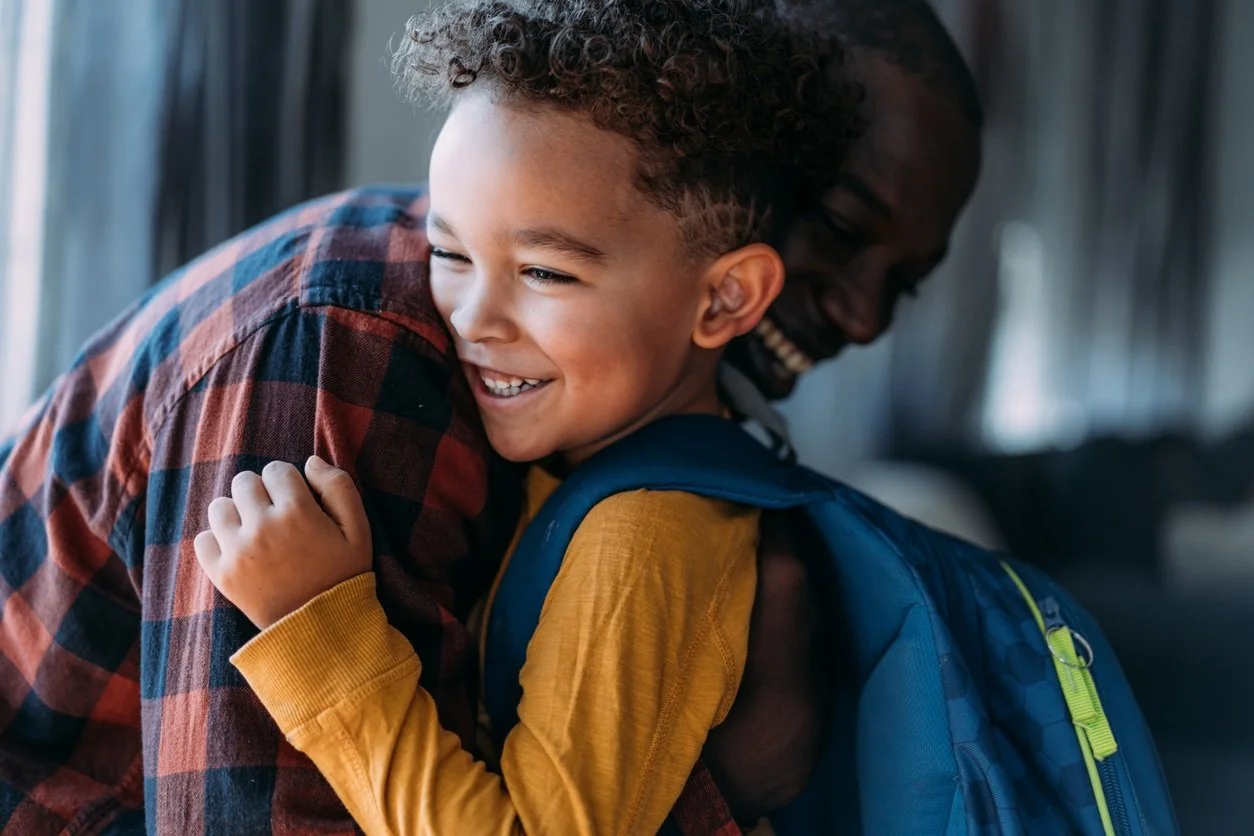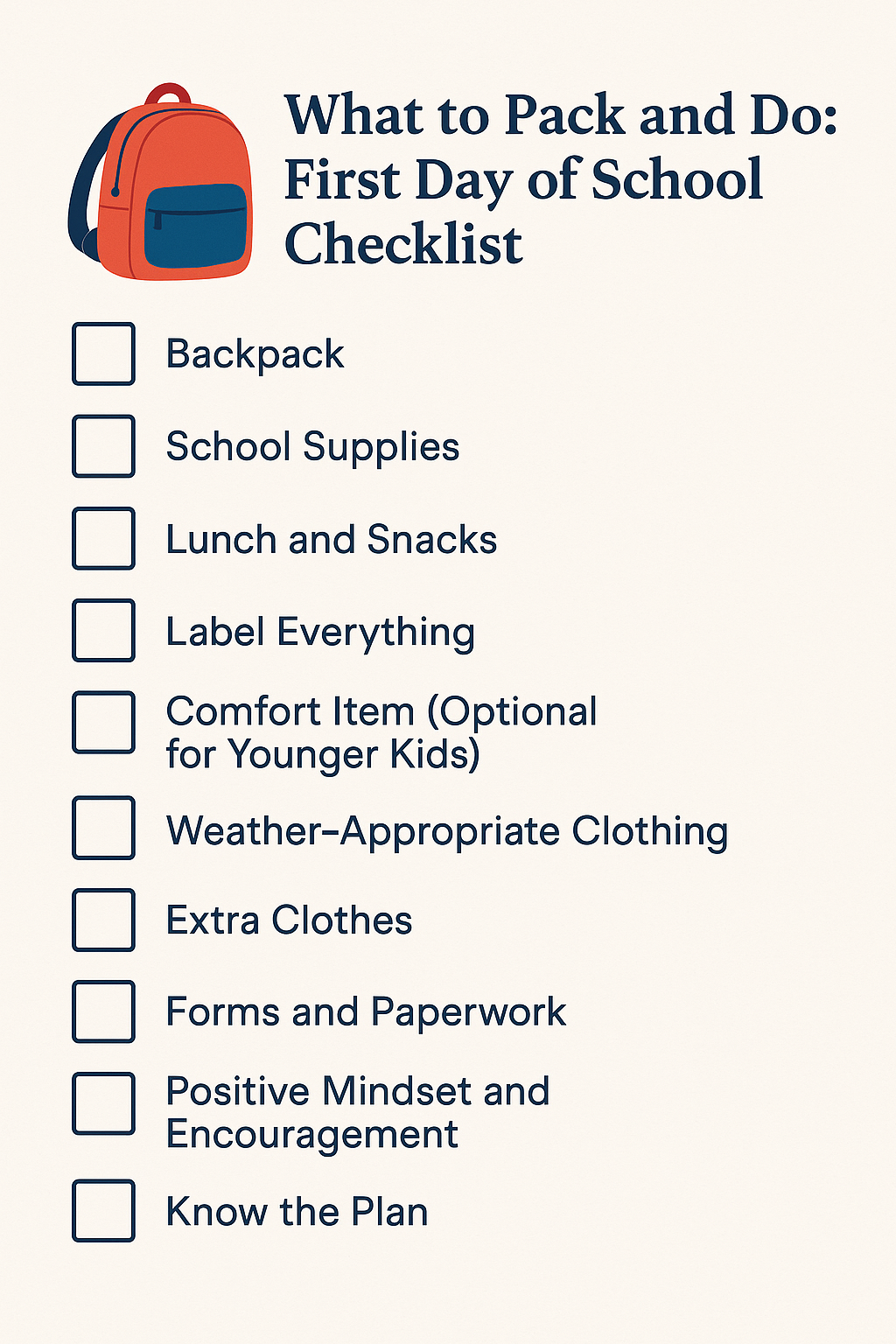First Day of School Checklist 2025: What Every K–5 Student Needs to Start the Year Right
The first day of school is a big moment for kids—and parents, too. Whether your child is starting Kindergarten or heading into 5th grade, being prepared can ease nerves and set the stage for a great year ahead. This checklist covers everything you need to pack, plan, and do to make that first day a smooth and special one.
The Importance of the First Day of School
The first day of school is a major milestone—especially for students in Kindergarten through 5th grade. It marks the beginning of new routines, new friendships, and new responsibilities. How your child experiences that first day can shape their mindset for the rest of the year, so preparing in advance and making it memorable matters.
When to Start Prepping for the First Day
Getting ready for school shouldn’t happen the night before. Instead, begin preparations at least 1 to 2 weeks ahead of time so you can reduce stress, ensure you don’t forget anything important, and help your child mentally adjust to the idea of going back. Gradual preparation also allows time to troubleshoot any surprises—like outgrown shoes or missing supply list items.
You can start by reintroducing earlier bedtimes, discussing daily schedules, and shopping for supplies. In the final few days before school starts, pack the backpack, try on clothes, and visit the school grounds if possible to build familiarity and confidence.
Planning for the First Day
Once you’ve started prepping, it’s important to think through the practical and emotional details that can make the first day smoother. Planning ahead ensures your child feels secure, knows what to expect, and starts school with confidence. Use the list below to cover all the bases as you approach the big day.
Review your school’s calendar and start time: Double-check the official first day, drop-off time, and pickup procedures.
Confirm transportation plans: Whether your child rides the bus, carpools, or walks, make sure they know exactly how they’re getting to and from school.
Visit the school if possible: Walking the halls, finding the classroom, and meeting the teacher ahead of time can ease nerves.
Establish a sleep and morning routine early: Begin waking up and going to bed on a school schedule at least a week in advance to avoid a rough first morning.
Create a checklist together: Involve your child in packing their backpack or choosing their first-day outfit to give them a sense of control and excitement.
Discuss what to expect socially: Talk about making new friends, asking for help, and what to do during recess or lunch.
Practice opening lunch containers and water bottles: Help your child feel confident managing their meals independently.
Prep for possible jitters: Normalize feeling nervous and come up with a strategy they can use if they feel unsure during the day.
Set expectations for behavior and manners: Reinforce listening to teachers, following rules, and being kind to classmates.
Plan for a calm morning: Reduce chaos by laying out clothes, packing lunch, and organizing supplies the night before.
What to Pack and Do: First Day of School Checklist
Being organized on the first day helps your child feel calm and confident. Below are 10 must-do tasks and items to pack—with context and examples—so your child walks into school ready to shine.
1. Backpack
A well-fitting backpack is essential for comfort and functionality. It should be large enough to hold folders, books, lunch, and supplies, but not so big that it overwhelms your child or strains their shoulders. Look for features like padded straps, water bottle holders, and a front pouch for smaller items.
Example: For younger kids, choose backpacks with fun themes like dinosaurs, outer space, or rainbows—they get kids excited to carry their gear.
2. School Supplies
Pack all required classroom materials before the first day to avoid last-minute stress. Many schools provide a supply list specific to grade level, so be sure to double-check and label each item. Keep everything neat in a zippered pouch or supply box your child can open easily.
Example: Include sharpened No. 2 pencils, crayons or markers, a glue stick, child-safe scissors, a pink eraser, and a wide-ruled notebook—all tucked into a labeled pencil pouch.
3. Lunch and Snacks
Make sure your child has a lunch they can manage on their own, with nutritious and familiar foods they enjoy. Use a lunchbox with compartments or bento boxes to keep food separated and appetizing. Don’t forget a refillable water bottle to stay hydrated throughout the day.
Example: A ham and cheese sandwich, sliced apples, crackers, and a small granola bar with a sticky note that says “I love you!” can make lunchtime feel special.
4. Label Everything
Young students frequently misplace things, so labeling all personal items is a lifesaver. This includes clothing, water bottles, lunch containers, and school supplies. Use waterproof name labels, a laundry-safe marker, or custom name tags for easy identification.
Example: Place your child’s name on their backpack, lunchbox, pencil pouch, water bottle, and jacket to help teachers return lost items quickly.
5. Comfort Item (Optional for Younger Kids)
Kindergarteners and first-graders may feel nervous about being away from home, especially on the first day. A small, discreet comfort item can offer emotional support without being disruptive. Make sure it fits easily in a pocket or the front pouch of their backpack.
Example: A smooth pebble from your backyard or a small plush keychain can act as a "secret strength" token they hold onto throughout the day.
6. Weather-Appropriate Clothing
Dress your child in layers to accommodate changing temperatures between the classroom and playground. Avoid hard-to-manage buttons or complicated fasteners for younger children. Make sure they wear comfortable shoes they can run and play in safely.
Example: Even if it’s hot in the afternoon, send your child in a short-sleeve shirt with a lightweight hoodie or sweater for cool morning temps or air-conditioned classrooms.
7. Extra Clothes
Accidents, spills, or muddy playground mishaps happen—especially in the early grades. Pack an extra outfit in a resealable bag that can be stored in the backpack or classroom cubby. This helps your child feel less embarrassed if they need to change.
Example: Include a spare T-shirt, pants or leggings, socks, and underwear in a labeled gallon-size Ziploc bag marked “Just in Case.”
8. Forms and Paperwork
The first day often requires turning in important forms to the teacher or school office. Organize them in a labeled envelope or plastic folder your child can hand off easily. Check your school’s welcome packet or website for anything that must be submitted.
Example: Health and emergency contact forms, allergy info, or medication authorization papers should be clearly labeled with your child’s name and teacher.
9. Positive Mindset and Encouragement
Help your child start the day with confidence by setting a calm, encouraging tone at home. Your energy and words have a huge impact on how they feel walking into school. Be upbeat and avoid showing your own nerves or stress.
Example: Say, “You’re going to meet so many new friends today!” or write a short affirmation like “You are brave and smart” on a sticky note and put it in their backpack or lunch.
10. Know the Plan
Before your child heads out the door, review what the day will look like—especially how it will end. Knowing who is picking them up, where they’ll go after school, and what to expect can reduce anxiety and build trust.
Example: Say, “After school, Grandma will pick you up right outside the classroom door—just like we practiced.” Repetition and clarity are key for younger students.
Additional Ways to Make the First Day of School Special
Beyond being prepared, small, thoughtful touches can turn the first day into a celebration. These ideas help build excitement and emotional connection, and create lasting memories for both of you.
Take First-Day Photos
Snap a fun photo before heading out the door to commemorate the milestone.
Example: Use a chalkboard or printable sign with their grade level and aspirations like “When I grow up, I want to be a veterinarian!”
Make a Special Breakfast
Start the day with your child’s favorite meal to boost their mood and energy. Pancakes in the shape of their initials or fruit arranged into a smiley face can turn breakfast into a mini celebration.
Leave a Lunchbox Surprise
Add something meaningful inside their lunchbox to brighten their day. A short handwritten note or a sticker with a message like “You’ve got this!” can offer comfort mid-day.
Walk In Together (If Permitted)
Being by their side helps ease nerves and shows your support. Take a few moments to walk your child to their classroom or line-up spot, offering a reassuring hug and goodbye ritual.
Plan a Mini After-School Celebration
Give your child something to look forward to after school is over. Go out for ice cream, have a pizza night, or let them pick a movie for the evening—celebrating their courage and success.
The first day of school is a fresh beginning filled with excitement, nerves, and new opportunities. With the right preparation, you can help your child walk into the classroom feeling confident, supported, and ready to learn. A little planning goes a long way in making this milestone a positive memory for both of you.
Related Blog posts
The Starglow Parenting Weekly
Your shortcut to purposeful parenting.
Join thousands of thoughtful parents who get our weekly roundup of tips on screen time, mindful discipline, and finding balance—delivered every Sunday morning.





